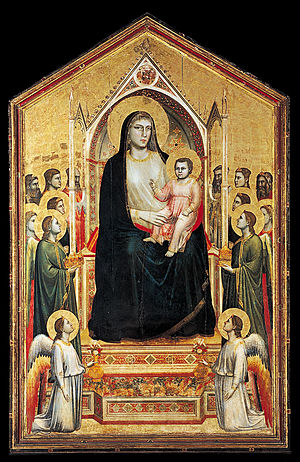Ognissanti Madonna

|
| Ognissanti Madonna |
|---|
| Giotto di Bondone , around 1310 |
| Tempera on wood |
| 325 × 204 cm |
| Uffizi Gallery , Florence |
The so-called Ognissanti Madonna is a painting by the Italian painter Giotto di Bondone . The enthroned Madonna with child, angels and saints was created around 1310 for the Ognissanti church in Florence . The painting is now in the Uffizi .
Image description
The Ognissanti Madonna is a large-format panel with a roof-like frame shape. The towering in the middle, umstandene of Holy and angels Madonna's importance perspective shown, that is, it is shown to emphasize their quasi divine Ranges greater than the surrounding figures. A background in today's sense is missing. The upper third of the throne and the figures are surrounded by gold ground, which, according to the understanding of the time, represented the divine light. This divine light continues as a halo down to the lower area. The body of the Madonna is depicted vividly, the sitting posture clearly emphasized by the choice of color. On closer inspection it can be seen that the gently smiling Madonna even has teeth. With her head and body posture, she still corresponds to the Byzantine face and gesture formula. Giotto gave his Madonna individual features. Steps lead gradually from the lower edge of the frame to a canopy-like housing, the Madonna is crowned by the arch of the canopy.
classification
There are a number of comparable depictions of the Madonna, including, for example, the Madonna of Cimabue Enthroned around 35 years earlier . The painting by Cimabue corresponds even more closely to the Byzantine face and gesture formula. The panel painting by Giotto is now classified as a work that is at the beginning of the development towards the Renaissance.
literature
- Nerdinger, Winfried: Perspektiven der Kunst , Oldenbourg 2006, ISBN 3-486-87517-5
Web links
Single receipts
- ^ Nerdinger, p. 51
